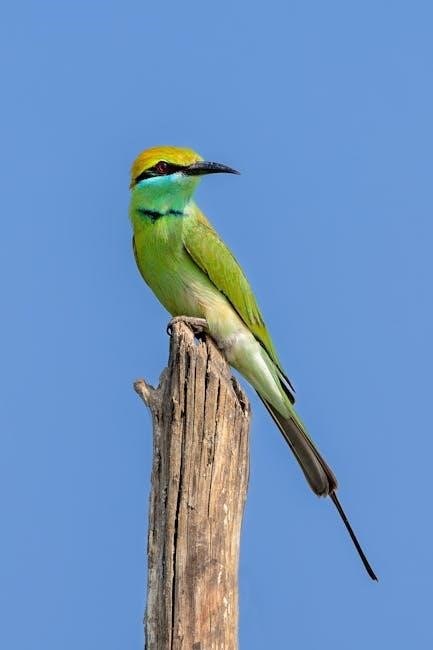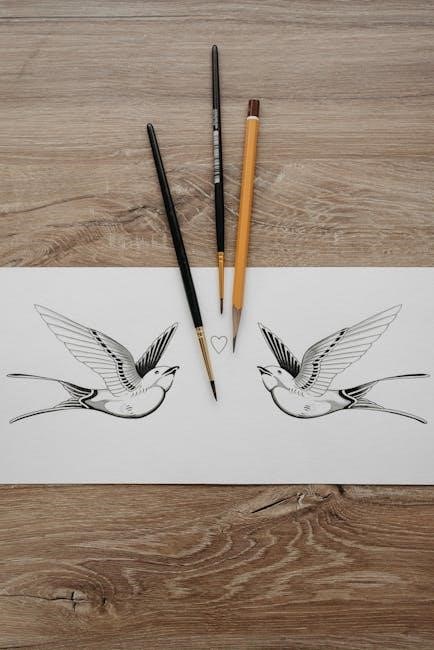Discover the world of bird drawing with John Muir Laws’ guide‚ perfect for artists and beginners‚ using
simple techniques
to improve artwork and inform birdwatching skills‚ making it a great resource always.

Overview of the Book
The Laws Guide to Drawing Birds is a comprehensive book that provides a thorough introduction to the art of drawing birds. The book is written by John Muir Laws‚ a renowned artist and naturalist‚ and is designed to be accessible to both beginners and experienced artists. The book takes a unique approach to teaching drawing skills‚ focusing on the importance of understanding the natural history and behavior of birds. Through a series of exercises and illustrations‚ the book shows how to capture the essence and beauty of birds in art. The book covers a range of topics‚ including the basics of bird anatomy‚ feather structure‚ and posture‚ as well as more advanced techniques for drawing birds in different environments and contexts. With its clear and concise instructions‚ and beautiful illustrations‚ the book is an essential resource for anyone looking to improve their bird drawing skills. The book’s approach is both artistic and scientific‚ making it a valuable resource for artists and bird enthusiasts alike.
Target Audience
The Laws Guide to Drawing Birds is designed for a wide range of readers‚ from beginner artists to experienced naturalists. The book is perfect for anyone who loves birds and wants to learn how to draw them‚ regardless of their artistic experience. It is also an excellent resource for art students‚ birdwatchers‚ and nature enthusiasts who want to improve their observation and drawing skills. The book’s clear and concise instructions make it accessible to readers of all ages and skill levels. Whether you are a serious artist or just starting to explore your creative side‚ this book provides a comprehensive guide to drawing birds. The author’s expertise and passion for bird drawing shine through on every page‚ making the book an enjoyable and informative read. With its unique approach and beautiful illustrations‚ the book is an essential resource for anyone who wants to learn how to draw birds. The book’s target audience is diverse and inclusive‚ making it a great resource for many different types of readers.

The Benefits of Drawing Birds
Drawing birds improves artwork and informs birdwatching skills using
various techniques
always.
Improving Artwork
Improving artwork is a key benefit of drawing birds‚ as it allows artists to develop their skills and techniques. By studying the shapes‚ forms‚ and textures of birds‚ artists can learn to render them accurately and realistically. The Laws Guide to Drawing Birds provides a comprehensive guide to improving artwork‚ with tips and techniques for drawing feathers‚ beaks‚ and other bird features. Using a range of mediums‚ including pencils‚ pens‚ and paints‚ artists can create stunning and detailed drawings of birds. The guide also covers topics such as composition‚ proportion‚ and perspective‚ helping artists to create balanced and visually appealing artwork. With practice and patience‚ artists can improve their artwork and create beautiful and realistic drawings of birds. The guide is suitable for artists of all levels‚ from beginners to experienced artists‚ and provides a valuable resource for anyone looking to improve their drawing skills. By following the guide‚ artists can take their artwork to the next level and create stunning drawings of birds.
Informing Birdwatching Skills
The Laws Guide to Drawing Birds also informs birdwatching skills‚ helping observers to better understand and identify birds in the wild. By studying the shapes‚ forms‚ and behaviors of birds‚ birdwatchers can improve their ability to recognize and distinguish between different species. The guide provides detailed information on bird anatomy‚ behavior‚ and habitat‚ allowing birdwatchers to gain a deeper understanding of the birds they observe. Using the guide‚ birdwatchers can learn to identify birds by their plumage‚ beak shape‚ and other characteristics‚ making them more effective and knowledgeable observers. The guide also covers topics such as bird migration patterns‚ nesting habits‚ and feeding behaviors‚ providing a comprehensive understanding of bird biology and ecology. By combining drawing and birdwatching skills‚ observers can gain a new appreciation for the beauty and diversity of birds‚ and develop a more nuanced understanding of the natural world. This integration of art and science enhances the birdwatching experience.

The Author’s Background
John Muir Laws is a naturalist and artist with degrees in conservation and wildlife biology‚ informing his work always with expertise and passion for nature.
John Muir Laws’ Expertise
John Muir Laws has established himself as a renowned artist and naturalist‚ with a deep understanding of the natural world. His expertise in conservation and wildlife biology has been honed through his academic pursuits‚ including degrees in these fields. This foundation in science informs his artistic approach‚ allowing him to capture the intricate details and nuances of the birds he draws. Laws’ expertise also extends to his ability to teach and share his knowledge with others‚ making him an effective educator and guide for those seeking to improve their drawing skills. Through his work‚ Laws demonstrates a unique blend of artistic talent and scientific knowledge‚ setting him apart as a leading authority in the field of nature drawing and journaling. His expertise has been recognized and respected by audiences worldwide‚ solidifying his position as a trusted and inspiring guide for artists and nature enthusiasts alike.
Published Works
John Muir Laws has authored several notable books‚ including The Laws Guide to Drawing Birds‚ which has sold over 60‚000 copies. His other published works include The Laws Field Guide to the Sierra Nevada and The Laws Guide to Nature Drawing and Journaling. These books showcase his expertise in nature drawing and journaling‚ and provide valuable guidance for artists and naturalists. Laws has also co-authored books‚ such as How to Teach Nature Journaling‚ demonstrating his ability to collaborate and share his knowledge with others. His published works have been well-received by audiences and critics alike‚ establishing him as a respected and trusted voice in the field of nature drawing and education. Through his writing‚ Laws continues to inspire and educate readers‚ promoting a deeper appreciation and understanding of the natural world. His books are a testament to his dedication to sharing his knowledge and passion with others.

Techniques and Tips
Learn essential
methods
for capturing bird postures and feathers with simple and effective drawing techniques always.
Understanding Bird Anatomy
To accurately draw birds‚ it is essential to understand their anatomy‚ including the structure of their feathers‚ beaks‚ and skeletons. The Laws Guide to Drawing Birds provides detailed information on the different types of feathers‚ such as flight feathers‚ tail feathers‚ and down feathers. Understanding how these feathers grow‚ overlap‚ and insert into the skin is crucial for creating realistic drawings. The book also covers the skeletal system of birds‚ including the shape and structure of their bones‚ which is necessary for capturing their postures and movements. By studying the anatomy of birds‚ artists can gain a deeper appreciation for their beauty and complexity‚ and create more accurate and detailed drawings. The guide provides a comprehensive overview of bird anatomy‚ making it an invaluable resource for artists and bird enthusiasts alike. The information is presented in a clear and concise manner‚ making it easy to understand and apply to drawing.
Refining Drawing Techniques
The Laws Guide to Drawing Birds offers a range of exercises and techniques to help artists refine their drawing skills. The guide provides tips on how to capture the texture and pattern of feathers‚ as well as the subtle curves and shapes of a bird’s beak and head. Artists can learn how to use different drawing tools and materials‚ such as pencils and ink‚ to create a range of effects and textures. The guide also covers the importance of observation and study in refining drawing techniques‚ encouraging artists to spend time watching and sketching birds in their natural habitats. By practicing these techniques and exercises‚ artists can develop their skills and confidence‚ and create more detailed and realistic drawings of birds. The guide’s focus on refining drawing techniques makes it a valuable resource for artists looking to improve their skills and take their drawings to the next level.